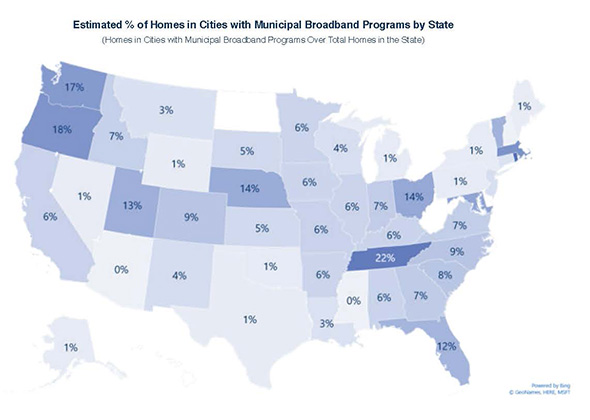 Eight percent of U.S. markets that are “well served” with broadband are “municipally enabled,” according to a new municipal broadband report from non-profit broadband advocacy organization US Ignite and consulting firm Altman Solon. The other 92% of well served municipalities get broadband from private service providers.
Eight percent of U.S. markets that are “well served” with broadband are “municipally enabled,” according to a new municipal broadband report from non-profit broadband advocacy organization US Ignite and consulting firm Altman Solon. The other 92% of well served municipalities get broadband from private service providers.
Moving forward, however, public and hybrid networks may be a viable alternative for bringing broadband to communities that are not well served, researchers said. The researchers estimate that there are 6,500 such communities nationwide.
In the 14-page report titled “Broadband Models for Unserved and Underserved Communities,” US Ignite and Altman Solon describe five viable models that they identified for municipally enabled broadband. The researchers noted that they also wrote case studies for each example, which are not included in the report but are available upon request.
The report references these examples only by municipality, but Telecompetitor has previously reported on some of these and we have provided links to our coverage.
The five models include:
- Full municipal broadband. This category includes more than two thirds (68%) of current municipally enabled networks. It includes deployments such as the one completed by EPB in Chattanooga in which a city or utility company owns and operates the network and serves end users.
- Publicly owned, privately serviced. With this model, which represents 17% of municipally enabled networks, one or more commercial partners serve end users and may operate infrastructure, but the municipality owns the infrastructure. An example of this comes from Westminster, Maryland and involves private service provider Ting.
- Hybrid ownership. With this model, the city owns middle mile infrastructure, but one or more private service providers own and operate last mile infrastructure, as well as serving end users. The white paper cites an example in Lincoln, Nebraska.
- Private developer open access. This category includes municipalities where a private developer owns and operates broadband infrastructure, but private service providers serve end users. The researchers reference Fullerton, California – a market where SiFi networks, Ting and GigabitNow have established a network of this type.
- Full private broadband. With this model, one or more service providers own and operate the network, as well as providing service to end users. While this might sound like the typical commercial network that comprises 92% of well served markets, the difference appears to be that the municipality becomes actively involved in attracting service providers by, for example, simplifying access to rights of way. Boston offers an example of this approach, the authors said.
The latter three categories combined comprise about 15% of municipally enabled networks, according to the white paper, which also includes a decision tree to help municipalities considering public, private and hybrid options to make the best choice, depending on their specific situations.
Where Are the Municipally Enabled Networks?
Municipally enabled networks are not specific to a particular region, the authors note. The report includes a U.S. map indicating the percentage of homes in each state that are in cities that have been involved in making broadband available through some type of municipal broadband program. While this percentage is zero in some states, it’s in the range of 20% in others. Tennessee has the highest percentage (22%), but other states, including Washington (17%) and Oregon (18%), were close behind.

The likelihood of a specific community having municipally enabled broadband varies by market size, with larger Tier 1 markets most likely to have a municipally enabled network. A press release about the new municipal broadband report notes, however, that moving forward, researchers see “growing support for hybrid public-private deployments and evidence that hybrid solutions may offer a viable approach for some communities lacking sufficient broadband coverage.”

Thumbnail image courtesy of flickr user Sean MacEntee.


